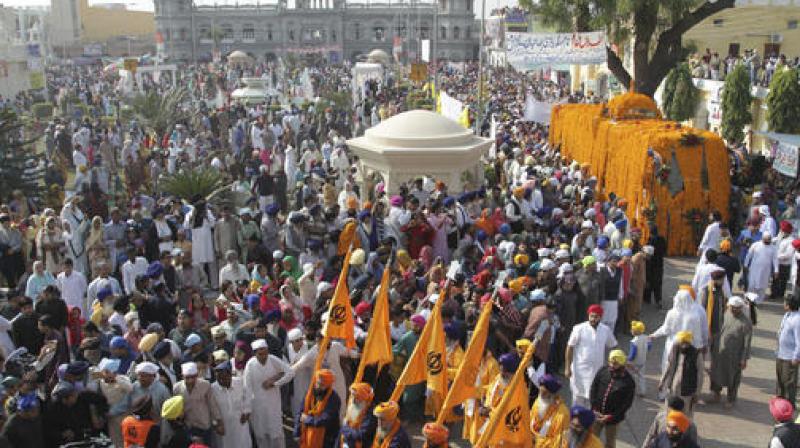Disquieting reports were received yesterday about the violent and dangerous assault by a Muslim mob on the Friday, 3rd January 2020 storming the Gurdwara Nankana Sahib near Lahore, Pakistan chanting anti-Sikh and pro-Islam slogans. The protesters reportedly surrounded the Gurdwara, pelted stones expressing anger against the Sikh community and some even shouted to destroy and re-christen it as Gulam-e-Mustafa. The following day, the Pakistan Foreign Office came out with its own negligent and insensitive version of the ugly incident completely negating the actual account citing it an altercation between two “Muslim” groups on a minor incident at a tea-stall. Several available videos, however, narrate and reflect an altogether different grim story about the insecurity and discrimination against the religious minorities, particularly Hindus and Sikhs.
Well, it is not the first incident in Pakistan and one would not expect any better from a country where the fundamentalists and militants operate under the overt and covert support of the army and government itself. Now let’s see how the same incident was reported by Indian media and press: The prominent news title of one reputed National English Daily, which boasts of the highest nationwide circulation, was as follows – “No Sikh Threatened, Fight Was Between 2 Muslim Groups: Pak”. On the other hand, one Hindi Daily with reasonable popularity and circulation said – “Pakistan Mein Nankana Sahib Par Hamla, CAA Birodhiyon Ke Liye Sabak; Kendra” (Attack on Nankana Sahib in Pakistan, A Lesson for Those Opposing CAA: Centre). In the former case, the news was published as a ordinary event; while in the latter case, it formed the prominent headline of the day.
Nankana Sahib is the birthplace of Guru Nanak Devji and, therefore, it is a holy and revered shrine for the entire Sikh community and many of their Hindu Brethren. Now suppose a reader does not go into the details of the aforesaid event, the two titles are bound to leave different perceptions and opinions about it among people. However, even if they choose to go into the nitty-gitty of the report, it would not have any significant change in perception and opinion thus formed. In the context of factual reporting of events bearing a direct or indirect impact on Indian masses, I have often noticed a certain bias in the mainstream international media and press of the countries in West and Gulf regions and, historically, Indian mainstream and powerful English media and press is generally found in sync with them. On the other hand, the reporting in vernacular languages has been more matter-of-factly and close to the ground reality and sensitivities of masses.
The aforesaid bias, perception and consequent opinion is best reflected in the recent nationwide protests on the Citizenship Amendment Act for the persecuted minorities from the three neighbouring countries organized by a section of political parties and fundamentalist religious groups by inciting students and peopleof a particular ideology and community; incidentally, many of them are quite allergic to and against the concepts of nationalism and/or Indian civilizational heritage too. It’s so easy to observe the contrast among some people contributing to the foreign and Indian English media and press as journalists and then back home actually found fanning the sentiments of people as activists through misinformation conducive to their line of reporting. On the other hand, if you actually visit some of the shabby shelters and camps and see the miserable living conditions of the persecuted refugees, it might cause a chill down your spine if you are sensible enough to human miseries.
Question is why some people conduct with such partition and insensitive or rather mischievous attitude so often blatantly reflected through the electronic media and press of the country and abroad! The incident is same but it is differently perceived by people as it suits them according to their interests and alignments, social and political. Their bias may be against the ruling dispensation or a community; this bias impacts their perceptions; the perceptions lead to opinion; and a potentially harmful narrative is formed in sync with the opinion. Ultimately, this narrative is put forth, published and widely circulated nationally and internationally. Many of such people and organization are so shameless and uncanny that they don’t even have any second thoughts in contradicting or deviating from their own previous opinions and well known stand on the same subject, so long it serves their current selfish motives and interests.
Of late, this is a very frustrating trend in Indian society and politics. Be it the case of meeting defence needs of the country such as Government-to-Government agreement on procurement of the Rafale fighter jets in 2016, law on the abolition of social evil of triple talaq of the Muslim women, abrogation of Article 370 on the Indian state of Jammu & Kashmir, Supreme Court judgment on the Ayodhya dispute hanging fire for the last seventy years, Citizen Amendment Act 2019 for the persecuted minorities in the neighbouring countries or the current outrage against Sikhs by fundamentalists in Pakistan, the opinion and narrative of a particular section of politicians, journalists and ultra-left liberals is always in unison, and so often synchronizes with the adversaries, or rather enemies, in the neighbourhood. One could understand the compulsions of some political parties and their sympathizers but they could still make distinction between a political issue or call and a national or public interest cause. In a zeal or hurry to oppose political adversaries or bring down the present ruling dispensation, they should not be seen pitted against the interest of people and the very nation itself.
Image source: Internet (Public Domain)
31,408 total views, 56 views today

















No Comments
Leave a comment Cancel